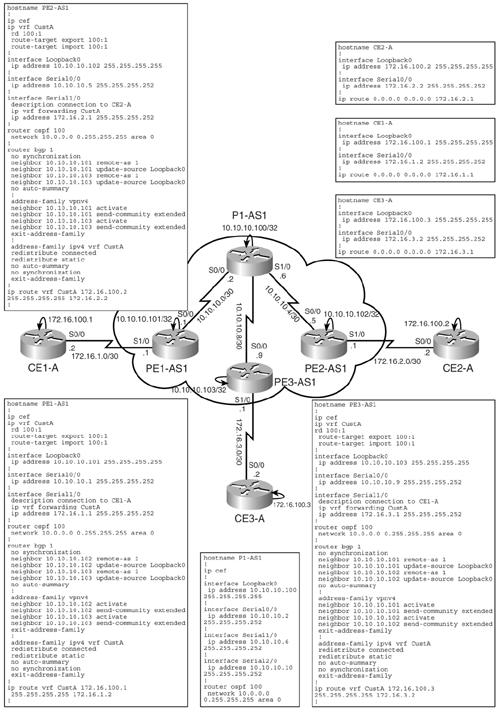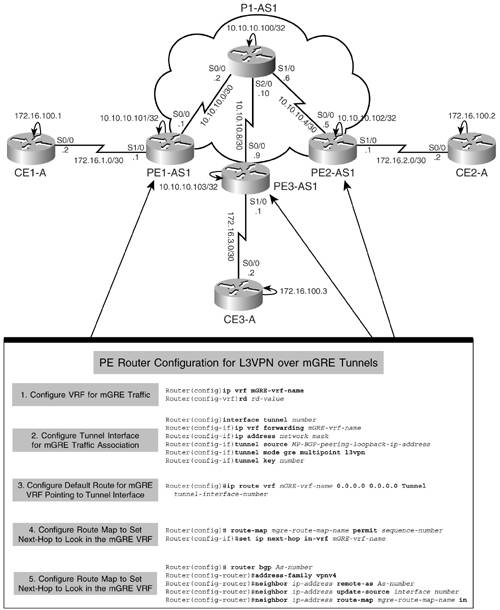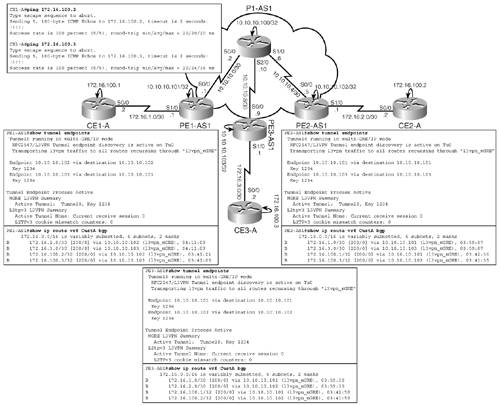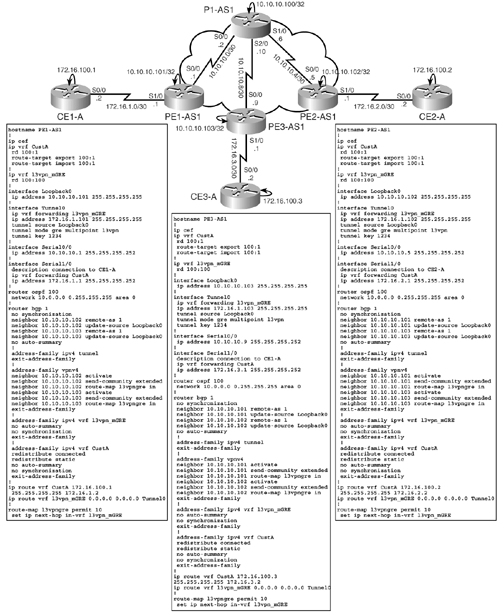Case Study 5: Implementing Dynamic Layer 3 VPNs Using mGRE Tunnels
Case Study 5 Implementing Dynamic Layer 3 VPNs Using mGRE Tunnels
This case study delves into the implementation of dynamic Layer 3 VPNs using mGRE tunnels. Implementation of mGRE tunnels creates a multipoint tunnel network as an overlay to the IP backbone that interconnects the PE routers to transport VPN traffic. The multipoint tunnel uses BGP to distribute VPNv4 information between PE routers. The advertised next hop in BGP VPNv4 triggers tunnel endpoint discovery. Dynamic L3 VPN implementation over mGRE tunnels provides the ability for multiple SPs to cooperate and offer a joint VPN service with traffic tunneled directly from the ingress PE router at one service provider directly to the egress PE router at a different SP site.
When implementing dynamic Layer 3 VPNs over mGRE tunnels, the addition of new remote VPN peers is simplified because only the new router needs to be configured. The new address is learned dynamically and propagated to the other nodes in the network.
In Figure 14-33, Customer A Routers CE1-A, CE2-A, and CE3-A are to be connected using dynamic Layer 3 VPNs over mGRE tunnels, by the SP routers PE1-AS1, PE1-AS2, and PE1-AS3. Static PE to CE is configured for the Customer A CE routers. In addition, no MPLS is configured in the core transport network and all traffic between Customer A sites is propagated using mGRE tunnels between the PE routers in the SP network.
Figure 14-33. Case Study 5: Topology and basic configuration for Layer 3 VPN over mGRE

Figure 14-33 shows the base configuration of devices prior to the implementation of Layer 3 VPN over mGRE tunnels. All configurations on the PE routers are similar to regular static PE to CE configurations except no MPLS is enabled on the core interfaces; mGRE tunnels are configured next to enable route propagation between PE routers that belong to Customer A.
Configuring Layer 3 VPN over mGRE Tunnels
Figure 14-34 shows the flowchart for configuration of the PE routers in addition to the configuration shown in Figure 14-33. The steps in the flowchart are outlined here:
|
Step 1. |
Configure an additional VRF to transport mGRE. |
|
Step 2. |
Configure a tunnel interface and assign it as part of the mGRE-associated VRF. Configure an IP address and a tunnel mode to be gre multipoint l3vpn. Also, configure the tunnel key. |
|
Step 3. |
Configure a default route for the mGRE VRF pointing to the tunnel interface. |
|
Step 4. |
Configure route-map to set the next-hop resolution to the mGRE VRF. |
|
Step 5. |
Associate the route-map inbound for VPNv4 routes learned from MP-BGP neighbors. |
Figure 14-34. Case Study 5: Layer 3 VPN over mGRE Configuration Flowchart

Figure 14-35 shows the Layer 3 VPN over mGRE tunnels configuration for the PE1-AS1, PE2-AS1, and PE3-AS1 routers. The highlighted portion depicts the important configuration steps for implementation of Layer 3 VPN over mGRE tunnels.
Figure 14-35. Case Study 5: Layer 3 VPN over mGRE Configuration

Verifications for Case Study 5
The verifications for Case Study 5 are shown in Figure 14-36.
Figure 14-36. Case Study 5: Verifications

Final Configurations for Layer 3 VPN over mGRE Tunnels for PE Routers
Figure 14-37 shows the final configurations for PE Routers PE1-AS1, PE2-AS1, and PE3-AS1. Configurations for the P1-AS1 router and the CE routers remain the same as shown earlier in Figure 14-33.
Figure 14-37. Case Study 5: Final Configurations for PE1-AS1, PE2-AS1, and PE3-AS1

MPLS Overview
- MPLS Overview
- Unicast IP Forwarding in Traditional IP Networks
- Overview of MPLS Forwarding
- MPLS Terminology
- MPLS Control and Data Plane Components
- MPLS Operation
- Special Outgoing Label Types
- Penultimate Hop Popping
- Frame-Mode MPLS
- Cell-Mode MPLS
Basic MPLS Configuration
- Basic MPLS Configuration
- Frame-Mode MPLS Configuration and Verification
- Cell-Mode MPLS over ATM Overview, Configuration, and Verification
- Command Reference
Basic MPLS VPN Overview and Configuration
- Basic MPLS VPN Overview and Configuration
- VPN Categories
- MPLS VPN Architecture and Terminology
- MPLS VPN Routing Model
- MPLS VPN Basic Configuration
- Outbound Route Filters
- Command Reference
PE-CE Routing Protocol-Static and RIP
- PE-CE Routing Protocol-Static and RIP
- Static PE-CE Routing Overview, Configuration, and Verification
- Static PE-CE Routing Command Reference
- RIPv2 PE-CE Routing Overview, Configuration, and Verification
- RIPv1 PE-CE Routing Configuration and Verification
- RIP PE-CE Routing Command Reference
PE-CE Routing Protocol-OSPF and EIGRP
- PE-CE Routing Protocol-OSPF and EIGRP
- OSPF PE-CE Routing Protocol Overview, Configuration and Verification
- EIGRP PE-CE Routing Protocol Overview, Configuration, and Verification
Implementing BGP in MPLS VPNs
- Implementing BGP in MPLS VPNs
- BGP PE-CE Routing Protocol Overview, Configuration, and Verification
- Implementing Route-Reflectors in MPLS VPN Networks
- Case Study-Hub and Spoke MPLS VPN Network Using BGP PE-CE Routing for Sites Using Unique AS Numbers
- Case Study-Hub and Spoke MPLS VPN Network with Sites Using Same AS Numbers
- Command Reference
Inter-Provider VPNs
- Inter-Provider VPNs
- Overview of Inter-Provider VPNs
- Option 1: Inter-Provider VPN Using Back-to-Back VRF Method
- Option 2: Inter-Provider VPNs Using ASBR-to-ASBR Approach
- Option 3: Multi-Hop MP-eBGP Between RR and eBGP Between ASBRs
- Option 4: Non-VPN Transit Provider
- Case Study-Inter-AS Implementing Route-Reflector and BGP Confederation in Provider Networks
- Case Study-Multi-Homed Inter-AS Provider Network
- Command Reference
Carrier Supporting Carriers
- Carrier Supporting Carriers
- Carrier Supporting Carriers Overview
- Deployment Scenarios with CSC Architecture
- CSC Architecture Benefits
- Command Reference
MPLS Traffic Engineering
- MPLS Traffic Engineering
- TE Basics
- MPLS TE Theory
- Constraint-Based Routing and Operation in MPLS TE
- Configuring MPLS TE
- Command Reference
Implementing VPNs with Layer 2 Tunneling Protocol Version 3
- Implementing VPNs with Layer 2 Tunneling Protocol Version 3
- L2TPv3 Overview
- Configuring L2TPv3 Tunnels for Layer 2 VPN
- Configuring L2TPv3 Static Tunnels
- Configuring L2TPv3 Dynamic Tunnels
- Implementing Layer 3 VPNs over L2TPv3 Tunnels
- Command Reference
Any Transport over MPLS (AToM)
- Any Transport over MPLS (AToM)
- Introduction to Layer 2 VPNs
- Implementing AToM for Like to Like Circuits
- L2 VPN-Any to Any Interworking
- Local Switching
- Command Reference
Virtual Private LAN Service (VPLS)
- Virtual Private LAN Service (VPLS)
- VPLS Overview
- VPLS Topology-Single PE or Direct Attachment
- Hierarchical VPLS-Distributed PE Architecture
- Command Reference
Implementing Quality of Service in MPLS Networks
- Implementing Quality of Service in MPLS Networks
- Introduction to QoS-Classification and Marking
- MPLS QoS Implementation
- MPLS QoS Operating Modes
- Modular QoS CLI: Configuration of QoS on Cisco Routers
- Configuration and Implementation of MPLS QoS in Uniform Mode and Short Pipe Mode Operation
- Implementing MPLS QoS for Layer 2 VPN Implementations
- Command Reference
MPLS Features and Case Studies
- MPLS Features and Case Studies
- Case Study 1: Implementing Multicast Support for MPLS VPNs
- Case Study 2: Implementing Multi-VRF CE, VRF Selection Using Source IP Address, VRF Selection Using Policy-Based Routing, NAT and HSRP Support in MPLS VPN, and Multicast VPN Support over Multi-VRF CE
- Case Study 3: Implementing Layer 2 VPNs over Inter-AS Topologies Using Layer 2 VPN Pseudo-Wire Switching
- Case Study 4: Implementing Layer 3 VPNs over Layer 2 VPN Topologies and Providing L2 VPN Redundancy
- Case Study 5: Implementing Dynamic Layer 3 VPNs Using mGRE Tunnels
- Case Study 6: Implementing Class-Based Tunnel Selection with MPLS Traffic Engineering
- Case Study 7: Implementing Hub and Spoke Topologies with OSPF
- Case Study 8: Implementing Hub and Spoke Topologies with EIGRP
- Case Study 9: Implementing VPLS Services with the GSR 12000 Series
- Case Study 10: BGP Site of Origin
- Command Reference
EAN: 2147483647
Pages: 130
